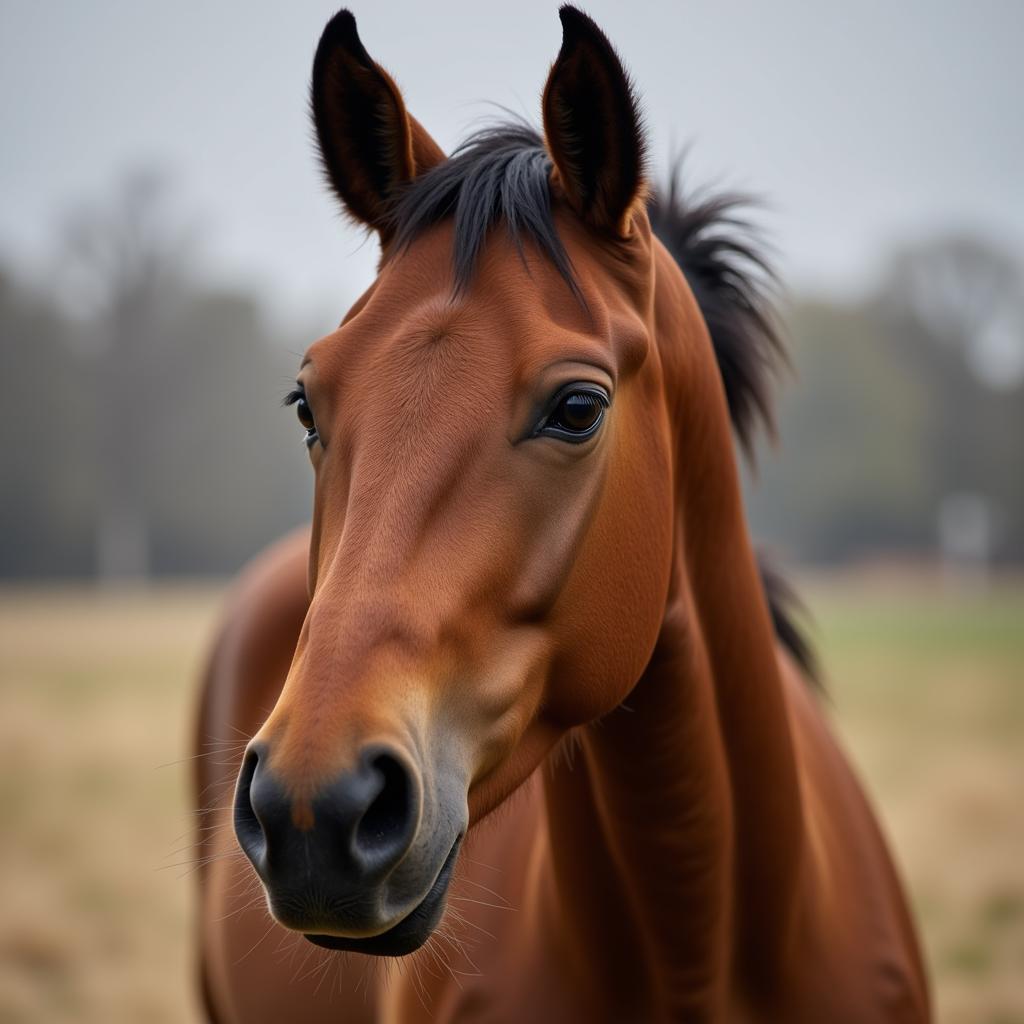A Cautious Horse, often displaying a watchful eye and hesitant demeanor, isn’t necessarily “bad” or “difficult.” Their cautious nature is often a result of their innate instincts, past experiences, or even their current environment. Recognizing the signs of a cautious horse and understanding the reasons behind their behavior is key to building trust and developing a safe and positive partnership.
Deciphering the Language of a Cautious Horse
Horses communicate primarily through body language. A cautious horse will exhibit a variety of subtle cues that can help you understand their state of mind. These cues can include:
- Head held high: With ears pricked forward, they are intently scanning their surroundings for any potential threats.
- Wide, watchful eyes: Their pupils may be dilated, taking in every detail of their environment.
- Hesitant movement: They may approach new objects or situations slowly, pausing frequently to assess the situation.
- Snorting or blowing: This is their way of clearing their airways and can be a sign of nervousness or uncertainty.
- Tail held tight: Unlike a relaxed horse whose tail swings freely, a cautious horse will often hold their tail stiffly.
 Cautious Horse Body Language
Cautious Horse Body Language
Factors Contributing to a Horse’s Cautious Nature
A horse’s cautiousness can stem from a variety of factors, and understanding these can help you tailor your approach:
- Genetics: Some breeds are naturally more sensitive or reactive than others.
- Past Experiences: A horse that has experienced trauma or inconsistent handling may be more wary and hesitant in new situations.
- Environment: A chaotic or unfamiliar environment can trigger feelings of anxiety and uncertainty in horses.
- Lack of Confidence in the Handler: If a horse doesn’t trust their handler, they are more likely to be cautious and uncertain.
Building Trust with a Cautious Horse
The cornerstone of working with a cautious horse is patience. Building a strong foundation of trust takes time and consistency:
- Move Slowly and Speak Softly: Avoid sudden movements or loud noises that could startle them. Use a calm and reassuring tone of voice.
- Positive Reinforcement: Reward any effort the horse makes to overcome their fear or hesitation with praise, gentle stroking, or a small treat.
- Desensitization and Counter-Conditioning: Gradually introduce the horse to new objects or situations in a controlled environment, pairing the experience with positive reinforcement.
- Consistency is Key: Establish a regular routine and be consistent in your handling and training methods.
When to Seek Professional Help
If you’re struggling to build trust with a cautious horse, or if their behavior is extreme, it’s essential to consult with a qualified professional. A veterinarian can rule out any underlying medical conditions, while a certified equine behaviorist can offer tailored advice and training strategies.
Embracing the Cautious Horse
While a cautious horse may require a more thoughtful approach, they often possess valuable qualities like intelligence, sensitivity, and a strong desire to please. By understanding their nature and investing the time to build a trusting partnership, you can help your cautious horse thrive and reach their full potential.
For further information on horse care and well-being, explore these resources:
Frequently Asked Questions about Cautious Horses
Q: Is a cautious horse dangerous?
A: Not necessarily. A cautious horse is simply reacting to their environment or past experiences. With patience and understanding, most cautious horses can become willing and trusting partners.
Q: How can I tell if my horse’s cautiousness is due to fear or pain?
A: If your horse’s behavior changes suddenly or is accompanied by other symptoms like lameness, weight loss, or aggression, consult with your veterinarian immediately.
Q: Can a horse’s environment impact its level of cautiousness?
A: Absolutely. A chaotic or stressful environment can make even the most laid-back horse nervous. Providing a safe, predictable, and enriching environment can significantly reduce anxiety.
Q: What are some common mistakes people make when handling a cautious horse?
A: Rushing the horse, using harsh training methods, or failing to recognize and address their fear can all exacerbate cautiousness.
Q: Can a cautious horse ever be ridden?
A: Yes, with patience, consistent training, and a focus on building trust, many cautious horses can become safe and enjoyable riding partners.
Remember, understanding and respecting your horse’s individual personality and needs is essential for a harmonious and successful partnership.
Need help caring for your cautious horse? Contact Justus Horses USA today. Call us at 0772127271, email us at [email protected], or visit us at QGM2+WX2, Vị Trung, Vị Thuỷ, Hậu Giang, Việt Nam. Our dedicated team of horse experts is here to help 24/7.